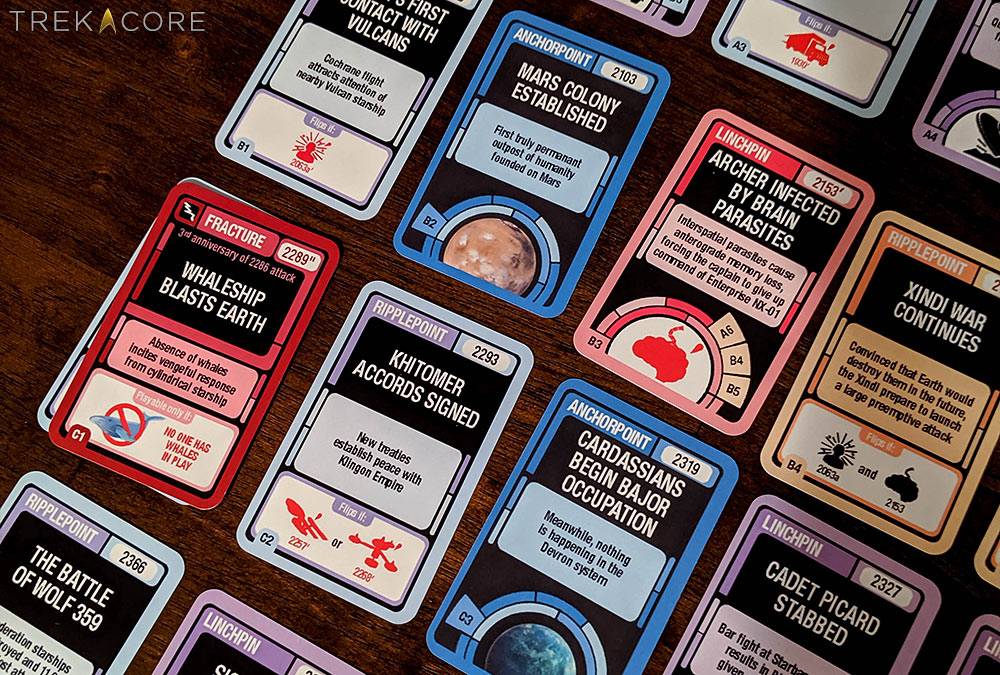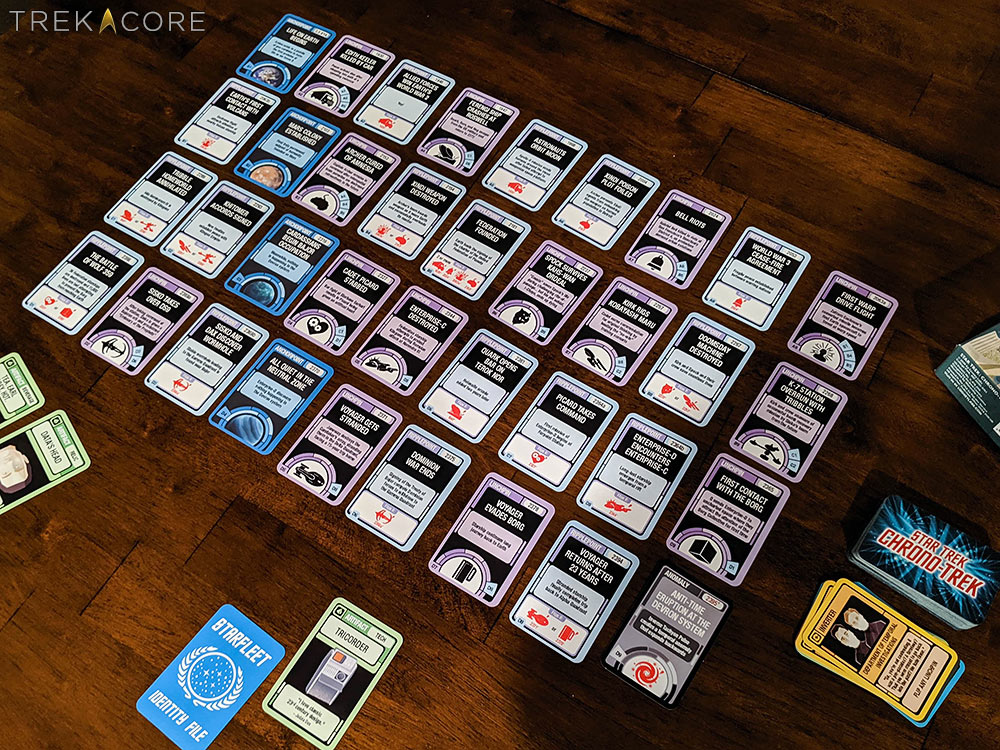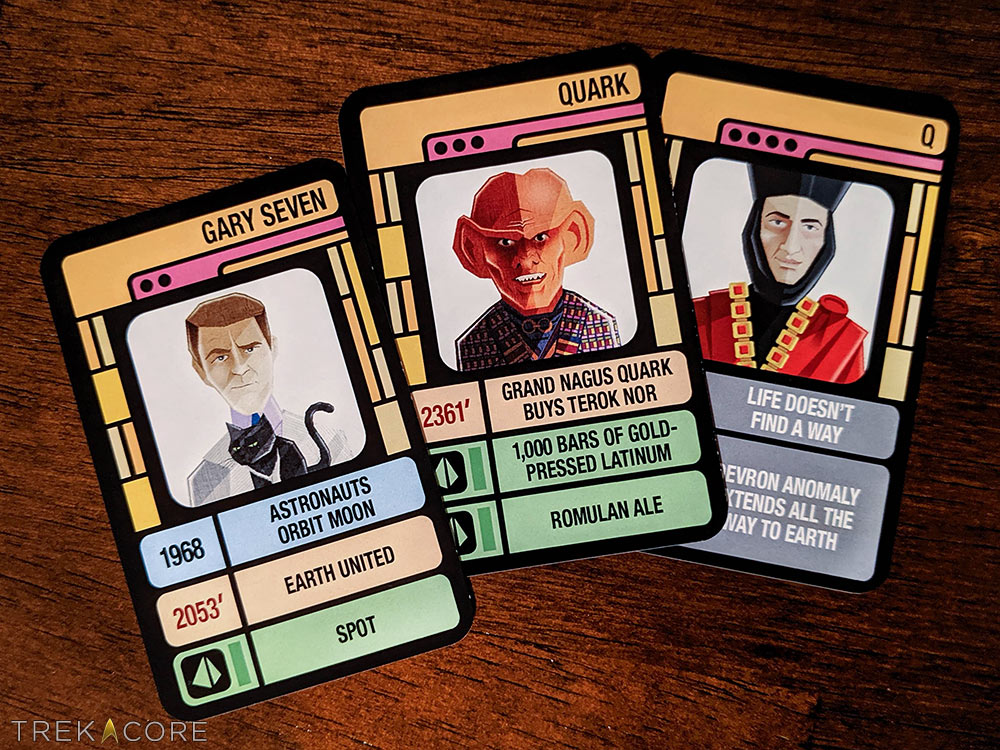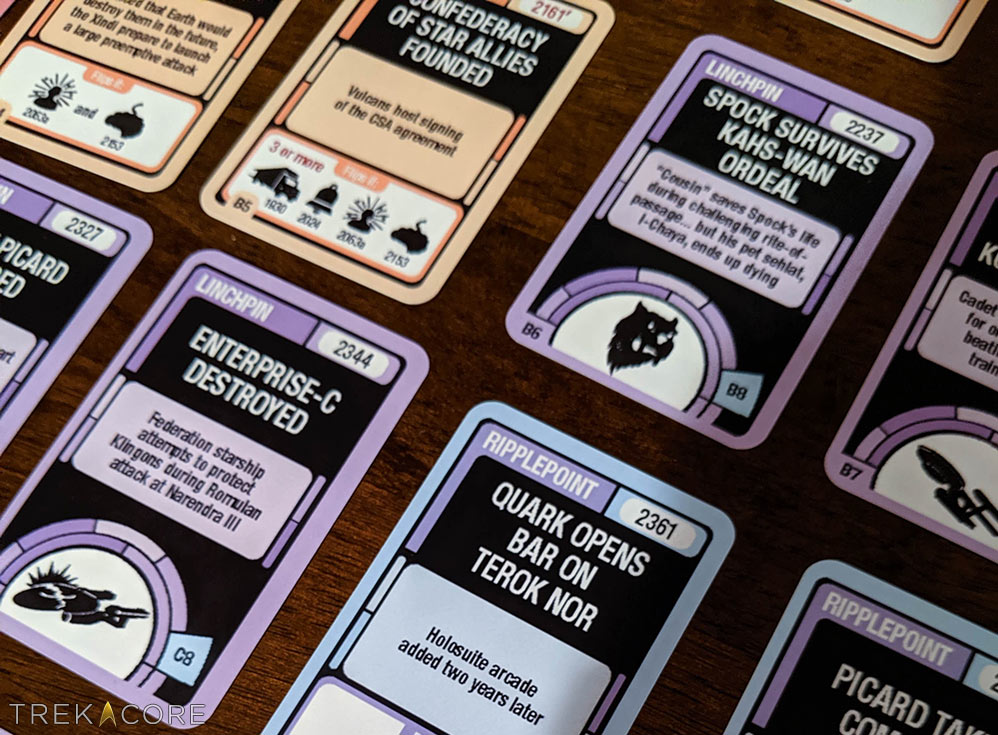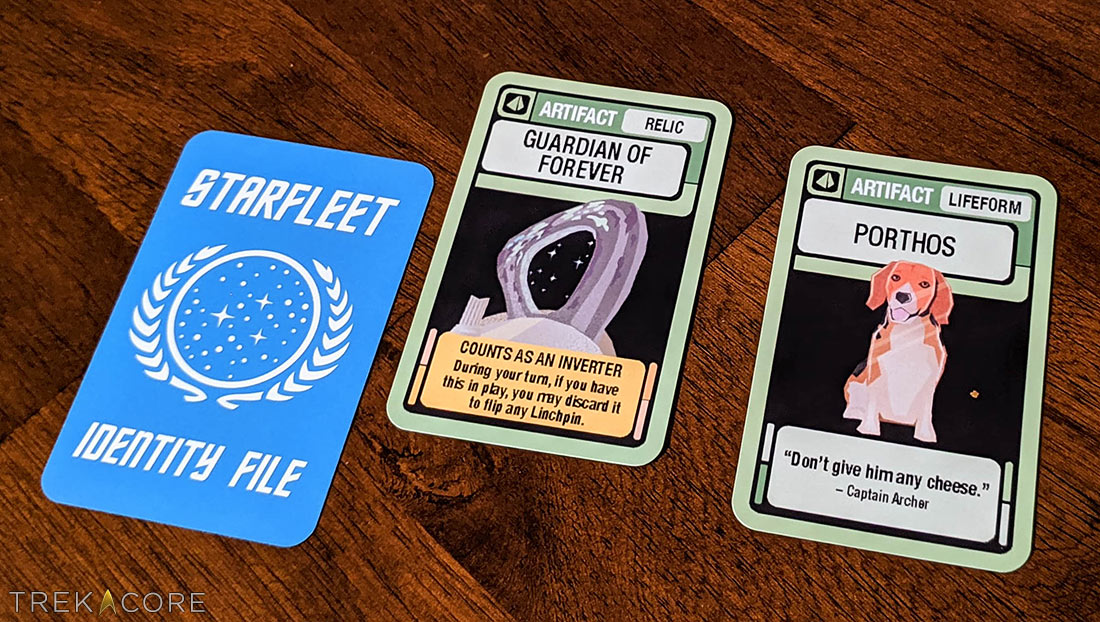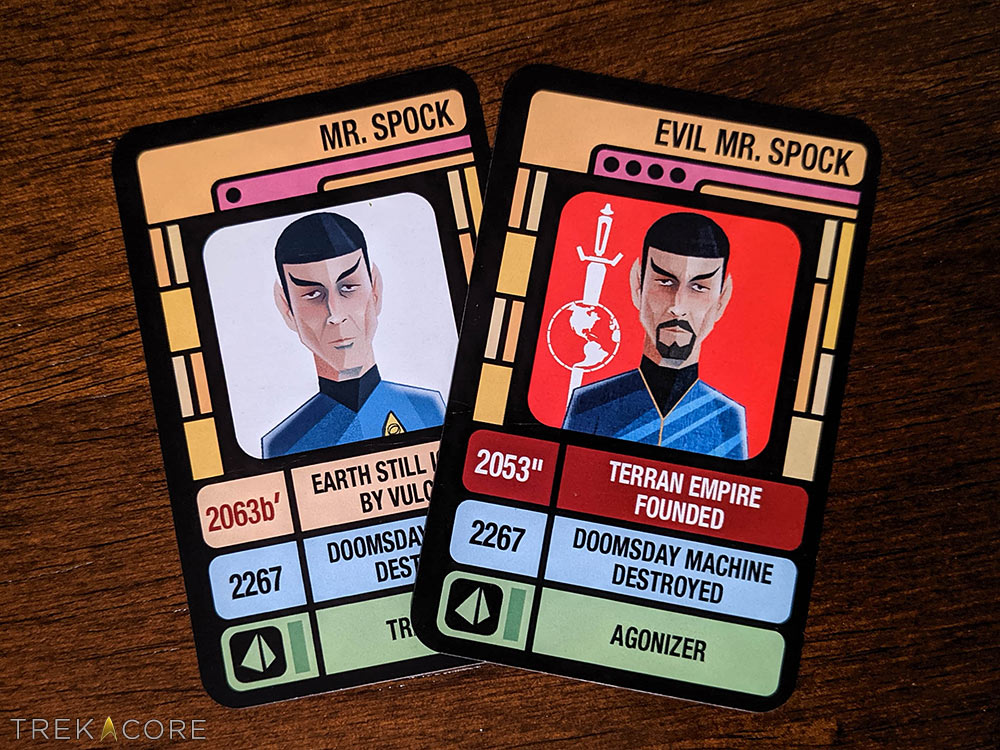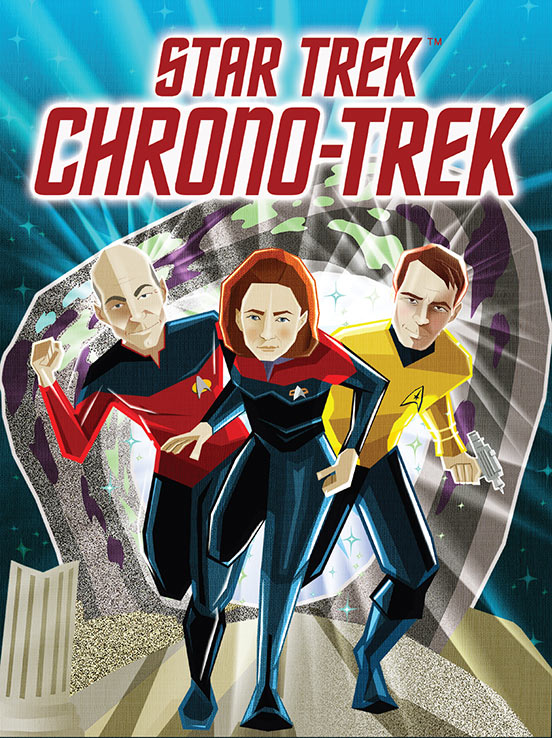Looney Labs is releasing the latest entry in its collection of Star Trek licensed games with Star Trek Chrono-Trek this summer — a themed re-imagining of their existing Chrononauts game, where time travelers jump through alternate histories and attempt to repair paradoxes caused by mischievous meddlers.
The Star Trek universe has no shortage of such time-hopping troublemakers and predestination problems that we’ve watched intrepid Starfleet crews tackle over the years. Now, it’s your turn to slingshot around the sun and change the fate of the multiverse!
Editor’s note: This review contains photos of a pre-production printing of Chrono-Trek provided to TrekCore by Looney Labs. While artwork and other content is final, any text legibility issues on the cards are expected to be resolved for the retail release.
This game boasts 32 possible identities for players to adopt, including the starship crewmembers from your favorite TV series, enemies (the Xindi and the Borg), potential allies (Gary Seven from “Assignment Earth” and Guinan), and folks just along for the ride (Berlinghoff Rasmussen from “A Matter of Time” and Cyrano Jones from “The Trouble with Tribbles”).
Each of them has a way to benefit from a potential alternate timeline – and since player identities are secret, you’ll never know who is working toward what temporal paradox until they drop an “Inverter” card and jump to a world where all tribbles have been eradicated from existence.
Star Trek Chrono-Trek uses the same art style as Looney Labs’ recent Fluxx games and the same core mechanic of Chrononauts; this game exists in a middle ground right between the two in terms of complexity and style of play. You lay out a sequence of 36 “Timeline” cards, forming a sort of central board with events from the history of Star Trek’s wide universe — which covers all the television series and films between from the early days of the Original Series to the final season of Star Trek: Enterprise.
By drawing and playing cards from the deck, you can flip over linked card sequences in the timeline to spawn alternate histories, collect creatures and relics (like humpback whales or Data’s severed head), or throw a self-sealing stem bolt into your neighbor’s warp drive by stealing away their items and cards.
The game has four difficulty levels based on how hard the characters’ goals are to accomplish. Level 1 and 2 are functionally equivalent, requiring one timeline divergence and one item for victory. The Fluxx-like chaos is on full display here, since there are so many cards that allow swiping items or fishing through the deck for specific cards.
In my experience, it was common for the game to end after only one or two rounds — often without some players getting a turn to play.
Where this game really shines is Level 3. The characters at this level require more conditions to be in place to win, preventing games from ending in a flurry of activity in the first few rounds. Players will have a chance to collect and play cards that counter each others’ actions; many goals among these characters are directly opposed or share required items, so there is a lot of built-in interaction that is missing from the lower difficulty levels.
Level 4 has villains who rely on “Fracture” cards for their nefarious plots. These cards represent escalated levels of paradox found when multiple variations in the timeline converge on a particularly extreme future.
For instance, if Quark profits from his trip to Roswell in 1947 (“Little Green Men”) by sharing advanced technology in the past and Benjamin Sisko takes a leave of absence instead of assuming command of Deep Space 9 (“Emissary”), it’s possible for the Federation to be “Conquered By The Dominion” – one of the key conditions for the Founders to win the game.
These Fractures also cause downstream effects through history – if another player relies on an event that takes place later in the timeline, they can no longer win the game as the timeline they need simply disappears from the universe until the events leading to the Fracture are repaired.
It’s possible to play with a mix of difficulty levels, with the harder levels granting players extra cards, but I would recommend keeping 1 and 2 separate from 3 and 4. Even just among level 4 characters, some only require two specific cards to win, while poor Emperor Kor needs a whopping six, the most of anyone in the game by far.
And if you draw Q, you are almost playing an entirely different game from everyone else — Q wins by waiting for the Devron anti-time anomaly (“All Good Things…”) to expand backward through time and prevent humanoid life from forming.
The “Event” cards that trigger the anomaly expansion are scattered through the deck and must immediately be played by any player drawing it, so Q is doing whatever he can to delay others from meeting their goals without having to focus on collecting items or altering timeline events.
The “Q wins” condition is just one great example of the incredible attention to Trek lore that is visible throughout this game. Timeline events, Inverter cards that alter history, and even the specific goals tied to characters, show a remarkable level of knowledge and care that went into crafting each card.
You can see deep cuts spanning all of the Star Trek series, like Andorian officer Thelin from “Yesteryear,” or that the timeline event “Borg destroyed by Voyager” as seen in the episode “Endgame” is technically an alternate history while “Voyager returns home after 23 years” — the original fate of Janeway’s crew — is the default position for the card.
Also great are subtle details in the character art, such as characters originating in alternate timelines (Admiral Janeway or Evil Spock from “Mirror, Mirror”) having slightly different lighting and texture to their illustrations when compared to crew from the original realities.
That same level of specificity put into every card also leads to a drawback, however: many “Action” cards allow you to search for a particular card by name from the deck, the discard pile, or another player’s hand. There are characters like Dr. Phlox, who needs to accumulate a collection of “Lifeform” or “Beverage” artifacts, and you may not know the names of every card in those categories off of the top of your head.
Similarly, every Inverter card does the same thing (flip a timeline card) but each one has a unique name of a time-travelling tool associated with it, like the Timeship Aeon (“Future’s End”). A cheatsheet for events necessary to trigger each Fracture card is included for players using Level 4 characters – a card listing all Artifacts or Inverters would be useful for players at every level of difficulty.
For more on how the game is played, we recommend this walkthrough demonstration with the gaming developers from this past March at the GAMA trade show.
Star Trek Chrono-Trek offers a chance to take a ride through the twists and turns of the Star Trek timeline, with the art (and chaos) you know from Looney Labs’ editions of Fluxx.
Keep and eye out for Chrono-Trek at your local game store this August, or look for it on sale at the FanSets booth at the Las Vegas Star Trek convention if you’re attending the event!

